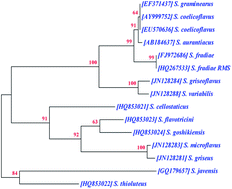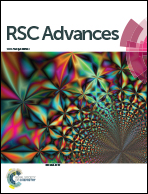Environmentally benign antifouling potentials of triterpene-glycosides from Streptomyces fradiae: a mangrove isolate†
Abstract
In the present study, an attempt has been made to screen and evaluate the antifouling potentials of the actinobacterial strain Streptomyces fradiae RMS-MSU isolated from the manakkudy mangroves of Tamilnadu. Screening results showed that the ethyl acetate extract of S. fradiae RMS-MSU displayed a wide spectrum of antagonistic activity (10 to 21 mm) against marine biofilm bacterial strains with least minimal inhibitory concentrations (MIC) and maximum bactericidal concentrations (MBC). The extract showed promising antimicroalgal activity with MIC values ranging between 100 and 400 μg mL−1. The anti-crustacean activity for 50% mortality (LC50) of Artemia salina was recorded as 273.77 μg mL−1. An EC50 value of 77.03 μg mL−1 for the 50% inhibition of byssus production and attachment of mussel Perna indica was observed. The crude extract of S. fradiae RMS-MSU showed an LC50 value of 718.79 μg mL−1 for 50% mortality of mussel. A therapeutic ratio (LC50/EC50) of 9.33 indicated the nontoxic nature of the extract. The mollusc foot adherence assay using the limpet Patella vulgata showed 6.66% fouling and 92.96% regaining at 7 mg mL−1 after transfer to fresh seawater.


 Please wait while we load your content...
Please wait while we load your content...